DESCRIPTION
|
LEGENDS OF THE GODS
|
Athens, Greece
Special Pre-Cruise Shore Excursion
"Walking in Plato's Footsteps": Acropolis, Parthenon, Erechtheion, Athena Nike, and Museum
($ Extra Charge)
Tues. Sept. 30, 2025
Tour: 11:00 am to 6:00 pm
(See ticket for meeting time/place)
Activity Level: Moderate
Pickup and drop-off at hotel (TBD) included
Special rate expires anytime
REGISTER HERE NOW
Excursion Highlights
• Experience the breathtaking Acropolis, a World Heritage Site, showcasing the rich cultural and political achievements of ancient Athens.
• Immerse in Greek antiquities at the National Archeological Museum, a treasure trove of art emphasizing rational thinking and democracy.
• Savor a delectable authentic Greek meal at Xenios Zeus in the Plaka, the oldest neighborhood in Athens, known for its charming, narrow streets and Neoclassical mansions.
• Tour includes round-trip transportation from your hotel (TBD), entrance fees to historic sites, and lunch, ensuring a seamless, stress-free adventure into the heart of Athenian culture.
Tour Description
Step back in time and immerse yourself in the glory of Ancient Athens with this exclusive Private Acropolis & Acropolis Museum Tour, topped off with a delicious local lunch.
Your guide will lead you through the awe-inspiring Acropolis, home to iconic landmarks such as the Parthenon, Erechtheion, and Temple of Athena Nike, sharing captivating stories of gods, heroes, and philosophers that shaped Western civilization.
Continue your journey at the Acropolis Museum, a modern architectural gem that houses ancient treasures and artifacts uncovered from the Sacred Rock. Marvel at the original Caryatids, intricate sculptures, and fascinating exhibits that bring ancient Athens to life.
After a morning of history and discovery, relax with a traditional Greek lunch at a handpicked local taverna in the Plaka. Savor authentic flavors and enjoy warm hospitality as you dine just steps away from the historic heart of the city.
This Athens tour is the ideal way to see the best of the city.

REGISTER HERE NOW
|
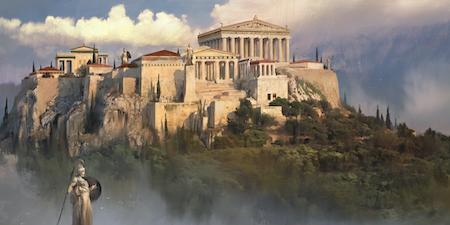
Legend of the Acropolis
At the very heart of the Acropolis stands a testament to the rivalry between Athena and Poseidon. According to legend, both deities coveted the city, offering gifts to claim it. Poseidon struck the rock with his trident, bringing forth a spring, while Athena offered the olive tree, symbolizing peace and prosperity. The city’s inhabitants chose Athena’s gift, thus naming the city Athens. The marks of Poseidon’s trident and the sacred olive tree are said to be found on the Acropolis, reminding visitors of this divine contest.
The Acropolis is not only home to the gods but also to the tales of fierce creatures like the centaurs. The mythical half-man, half-horse beings were known for their battle with the Lapiths, which is depicted in the metopes of the Parthenon. This myth serves as a reminder of the eternal struggle between civilization and barbarism. It is a theme that resonates throughout Greek mythology.
The Erechtheion, with its porch of Caryatids, tells the poignant story of these maiden statues. Legend has it that they represent the women of Caryae, punished by being forced to bear the weight of the temple’s roof for betraying Athens. The Caryatid Women, adorned in elegant dresses and exhibiting poised stature, symbolize two contrasting concepts. They represent both the burden of treachery and the dignity of eternal service. Their presence offers visitors an evocative narrative to contemplate.
The Acropolis is also the backdrop for the heroic sagas of Theseus. Theseus is the legendary king of Athens who defeated the Minotaur. Legends say that Theseus walked these very grounds, and the festivals held in his honor connected mortals with the divine. His tales of bravery and adventure echo through the marbled pathways and continue to inspire those who climb the Acropolis Hill.
DETAILS
Food and Beverage
Lunch is included in the price. Beverages are available for purchase. Bring bottled water from the ship.
Recommended Dress
Comfortable clothing, sensible, flat-soled walking shoes, sunglasses, sunscreen, and hat or umbrella are suggested.
Restrictions
The minimum age to consume alcohol is 21. Guests must be able to walk over cobblestones and uneven surfaces, inclines and steps. This tour is not wheelchair accessible.
Meeting Instructions
Details will be provided on your ticket.
REGISTER HERE NOW
|
|
Alexandria, Egypt (Overnight Stay)
"Mysteries of Sakkara and the Serapeum"
($ Extra Charge)
Fri. Oct. 3, 2025: in Port 7:00 am
Tour: 7:00 am to approx. 7:00 pm
(See ticket for meeting time/place)
Activity Level: Easy
Special rate expires anytime
REGISTER HERE NOW
Tour Description
After breakfast, we depart for Sakkara (approx. 3.5 hours' drive), the vast necropolis that houses the Step Pyramid of Djoser—the earliest known pyramid in Egypt and a groundbreaking example of ancient architectural innovation.
Our exploration includes the mysterious Serapeum, a subterranean complex where you'll encounter **23 massive granite and stone sarcophagi, each carved with astounding precision. We'll also visit a beautifully preserved **Old Kingdom tomb, providing an authentic glimpse into the art, daily life, and beliefs of ancient Egyptians.
Following the visit, we enjoy a *homemade lunch at a local house restaurant.
Around 5:00 PM we take a comfortable drive back to *Alexandria Port, where we will **overnight aboard our ship.*
Our Tour Guide
Mohamed was born and raised in Badrashien, a historic town in Giza that is home to some of Egypt’s most remarkable ancient sites—including Memphis (the first capital of Ancient Egypt), Sakkara, Dahshur, Abusir, and more.
Mohamed’s passion for history led him to study not only Ancient Egypt, but also Greco-Roman, Coptic, Islamic, and Modern Egyptian history. He explored diverse fields including archaeology, art, religion, and the Ancient Egyptian language.
In 2000, he earned his bachelor's degree from Helwan University in Cairo.
Driven by his deep curiosity, Mohamed immersed himself in advanced historical research and had the opportunity to work with many experts across different disciplines—all sharing a deep fascination for Ancient Egypt. Through these collaborations, he developed a multi-faceted understanding of Egypt’s vast legacy.
Today, Mohamed teaches about Ancient Egypt’s Advanced Lost Technologies, Pre-Diluvian Civilizations, and Healing Practices in Ancient Egypt. More recently, he has been exploring and lecturing on the fascinating topic of Star Gates in Ancient Egypt.
He is also the author of Egypt Before The Written History, which became an Amazon bestseller in November 2023.
Thanks to his extensive knowledge, Mohamed is frequently invited as a guest speaker at conferences both in Egypt and internationally.
With over 20 years of experience as a professional tour guide, Mohamed is dedicated to bringing Egypt’s timeless wonders to life for visitors from around the world.
Meeting Instructions
Details will be provided on your ticket.

REGISTER HERE NOW
|

Legends of the Serapeum
The Serapeum of Sakkara has been a continuous source of speculation and mystery since its re-discovery in 1850. Even now, no theory has been able to explain exactly how or why the 24 giant sarcophagi were moved to the site and precisely installed in their notches. The mainstream theory suggests the site was used for the burial of Apis bulls, though there are many elements which do not add up with this belief.

For example, the size of the boxes exceeds the size of the bulls; was it done to provide extra comfort for them? Why not do the same for the pharaohs, who were buried in tiny coffins barely fitting their bodies? Why did they make the Serapeum sarcophagi out of granite and not with limestone, a material much easier to work with? And if Serapeum was the burial site for the Apis bulls, where are the bull mummies?

Several people reject the theory of the Serapeum having been used for ceremonial burials (at least not in the grand gallery of the site where the large coffins are located), but if not that, then what was it used for? That is the question posed by some Egyptologists.


REGISTER HERE NOW
|
|
Alexandria, Egypt (2nd Day)
"Mysteries of the Giza Plateau"
($ Extra Charge)
Sat. Oct. 4, 2025: in Port until 8:00 pm
Tour: 7:00 am to 7:00 pm
(See ticket for meeting time/place)
Activity Level: Easy
Special rate expires anytime
REGISTER HERE NOW
Giza Plateau Tour
After breakfast, we drive to Giza (3 hours). After arrival we begin our journey to Egypt’s most iconic archaeological site: the Giza Plateau.
Our exploration starts with the awe-inspiring Great Pyramid, known in ancient times as Akhet Khufu (“Horizon of Khufu”). As we walk around its massive base, we will uncover hidden details often missed by casual visitors, including mysterious cut marks on the basalt pavement—an enigma still debated by scholars and engineers today.
Next, we’ll drive to the Second Pyramid, attributed to Khafre and known in ancient texts as (Wr Mr).
Here, we’ll explore the remains of the Mortuary Temple, where you'll witness the
sheer scale of the megalithic limestone blocks and remnants of alabaster flooring, still partially preserved.
Our path then leads us on foot to the Valley Temple, attributed to Khafre. From within this beautifully preserved structure, we’ll take a shortcut that brings us directly to the feet of the legendary Great Sphinx. Here, we delve into an alternative geological theory proposing that the Sphinx may date back to before the last Ice Age—around 9700 BC. We'll examine weathering patterns and discuss intriguing evidence that challenges conventional timelines.
After exploring the Giza Plateau, we will head to a local restaurant to enjoy a delicious lunch and relax before driving back to Alexandria and end of the day, we arrive to the ship at 7:00 PM
Our Tour Guide
Mohamed's passion for history led him to study not only Ancient Egypt, but also Greco-Roman, Coptic, Islamic, and Modern Egyptian history. He explored diverse fields including archaeology, art, religion, and the Ancient Egyptian language.
With over 20 years of experience as a professional tour guide, Mohamed is dedicated to bringing Egypt’s timeless wonders to life for visitors from around the world. See his complete biography above, in the tour description for the date of Oct. 3.
Meeting Instructions
Details will be provided on your ticket.

REGISTER HERE NOW
|

Legends of the Pharoahs
Edgar Cayce taught that the secrets of Atlantis and knowledge of the future are buried under the right front paw of the Sphinx at the foot of Giza Plateau.
Built thousands of years ago, the pyramids remain enigmas to scientists as well as to seekers of the unknown.
The first person to enter the Great Pyramid of Cheops in post-Pharaonic times was the caliph of Baghdad, Abdullah al-Ma’mun, in AD 820. He forced his way in by heating rocks, then breaking them by pouring on vinegar.
As generations of scientists and tourists, eccentrics and treasure hunters followed him, pyramid mystique grew over the ages.
Perhaps the most famous personality to enter in search of the occult was Napoleon Bonaparte, who spent the night of Aug. 12, 1799, inside Cheops’ pyramid and emerged ashen and shaken.
He went to his grave in 1821 without telling what he experienced.
“No! What’s the use,” Napoleon was said to have told a friend. “You wouldn’t believe me anyway.”
Cheops is made of 2.3 million blocks, each one weighing 2 1/2 tons to 15 tons, each side at an angle of 51 degrees, 50 minutes and 35 seconds. Many people think the pyramids were built by extra-terrestrials, or survivors from the lost continent of Atlantis.



REGISTER HERE NOW
|
|
Limassol, Cyprus
"Paphos Mosaics and Cult of Aphrodite"
($ Extra Charge)
Mon. Oct. 6, 2025: in Port 8:00 am to 5:00 pm
Tour: 10:30 am to 3:30 pm
(See ticket for meeting time/place)
Activity Level: Moderate
Special rate expires anytime
REGISTER HERE NOW
Excursion Highlights
• Visit the legendary birthplace of the Cypriot goddess of love, Aphrodite.
• Journey to Paphos to view the famed Dionysos mosaics—the finest in the Mediterranean.
• Marvel at the extraordinary rock-carved Tombs of the Kings.
• Enjoy free time for shopping or savoring local delicacies.
Tour Description
Begin with a scenic drive through Phassouri's citrus groves and vineyards, arriving at Petra tou Romiou (Aphrodite's Rock), the symbol of Paphos city. This iconic coastal site symbolizes love and beauty in Cypriot mythology. Legend tells us that here, Aphrodite, the goddess of Cyprus, was born from the foam of the sea and was carried by the waves on the coasts of Cyprus to Paphos—the sacred place where Aphrodite was venerated.
The religion of Cyprus in antiquity was that of ancient Greece. Most of the Olympian gods were worshipped in Cyprus but the most important cult was that of Aphrodite, the Cypriot goddess. She is the embodiment of the fertilizing dynamism of Love, fertilizing the whole nature and spreading happiness. Archaeological evidence and inscriptions bear witness of the existence of numerous sanctuaries and temples dedicated to the goddess throughout Cyprus.
Continue to Paphos, a World Heritage Site and one of the most beautiful places of Cyprus—a charming harbor town with Roman ruins, medieval churches, and vibrant culture.
Of Phoenician origin, although the region was inhabited since Neolithic times, in Hellenistic and Roman times it was the capital of Cyprus and home of the Aphrodite cult, as well as of other pre-Hellenic fertility deities.
Paphos houses the colorful Dionysos mosaics, picturesque churches, medieval monasteries, museums, countless antiquities, and a lovely harbor guarded by a small castle. The present city of Paphos, together with Palepafo, was declared a World Heritage Site in 1980 due to the exceptional value, both historical and architectural, of the remains of villas, palaces, theaters, fortresses and tombs. The findings include the sanctuary of Aphrodite, a necropolis of the eleventh century BC, the sanctuary of Apollo, catacombs, baths of the Byzantine period and Middle Ages, and more.
In 1962, a Cypriot farmer made an accidental discovery that would forever change the history of Cyprus—a small mosaic that was only the tip of the iceberg. Subsequent excavations revealed that the vast terrain contained an extensive complex of buildings, fitted with floors considered to be the most spectacular mosaics in all the Mediterranean, representing Roman legends but mostly scenes from Greek mythology.
Located among the ruins of four Roman villas, The House of Dionysos, dating to the 2nd century A.D., features mythological themes in most of its mosaics. An extraordinary representation of a battle with the Minotaur in the House of Theseus; the House of Aeon, and the House of Orpheus complete the collection of Roman villas with incredibly well-preserved mosaics.
We will then visit the Tombs of the Kings, an underground necropolis (cemetery) of Paphos, with open peristyle courts surrounded by burial chambers. This monumental Ptolemaic period complex of several impressive tombs carved into the rock and decorated with columns dates from the fourth century BC.
There will be free time at Old Harbour (Limanaki), offering a mix of local crafts and international goods. There you may stroll around, shop for souvenirs, or have a drink in one of the many bars of this small tourist port. At the end of the excursion, return to Limassol port.

REGISTER HERE NOW
|
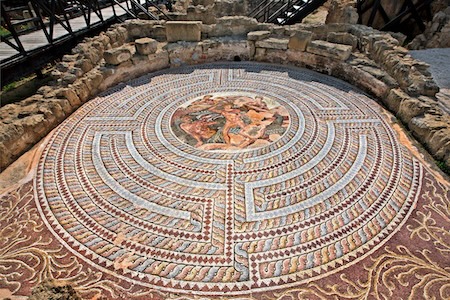

Legend of Aphrodite
Legend has it that Paphos was home of Aphrodite, goddess of beauty and love. Still under the spell of the goddess, the area retains her magic and has remained intact by time. It seduces its visitor with its majestic landscape, lovely coastline and historical treasures. Paphos itself is a leading cultural centre of the Mediterranean and the whole town is on the World Heritage list.
Wherever one treads in Paphos one comes across a glorious history which dates back thousands of years, when the cult of goddess Aphrodite flourished in this beautiful part of the world attracting many visitors from inland and abroad.

DETAILS
Food and Beverage
Passengers may enjoy snacks at their own expense.
Recommended Dress
Comfortable clothing, sensible, flat-soled walking shoes, sunglasses, sunscreen, and hat or umbrella for sun shield, euros for shopping and souvenirs.
Restrictions
This tour is not wheelchair accessible and cannot accommodate wheelchairs, motorized scooters, or walkers. Guests must be able to enter and exit the vehicle independently. Walking is involved. Guests must navigate some stairs, steps, and uneven terrain.
Meeting Instructions
Details will be provided on your ticket.
REGISTER HERE NOW
|
|
Alanya, Turkey
"Dolphin and Sea Turtle Cruise and Swim with Lunch"
($ Extra Charge)
Tues. Oct. 7, 2025: in Port 8:00 am to 5:00 pm
Tour: 10:30 am to 3:30 pm
(See ticket for meeting time/place)
Activity Level: Easy
Special rate expires anytime
REGISTER HERE NOW
Excursion Highlights
• Enjoy an amazing day cruise around the Alanya Peninsula in a luxury yacht.
• Visit Pirates Cave, Lovers Cave, and Phosphorus Cave.
• Interact with playful dolphins and sea turtles.
• Watch cliff divers leaping off high rocks into the sea.
• Visit legendary Cleopatra's Beach.
•
Savor a sumptuous lunch aboard your luxury yacht.
• Indulge in a beauty session with a sea mud mask.
Tour Description
Experience an unforgettable day cruise around the Alanya Peninsula, a must-do for all adventure seekers and nature enthusiasts.
Watch the Red Tower, shipyard and the Medieval walls of Selcuk's Castle melt into the horizon as you sail around the Alanya Peninsula.
Dive into the warm sea waters at Pirates Cave, Lovers Cave, and Phosphorus Cave, as you swim and snorkel with playful dolphins and sea turtles.
Witness the heart-racing spectacle of cliff divers leaping off high rocks into the sea, while swimming or lounging on the famous sands of Cleopatra's Beach.
Then head to New Harbor to savor a sumptuous lunch of grilled chicken, rice, salad, and seasonal fruits onboard your luxury yacht, with options for wine or coffee.
Continue to Ulas beach for an afternoon swim or unwind with an impromptu beauty session with a sea mud mask.
REGISTER HERE NOW
|


DETAILS
Food and Beverage
Lunch and soft drinks are included in the price; alcoholic and hot beverages are available for purchase.
Recommended Dress
Comfortable seasonal clothing, swimwear underneath clothing, bring towel from ship (for optional swimming), sunscreen, sensible flat-soled walking shoes, hat, sunglasses, camera for photos, euros for shopping and souvenirs.
Restrictions
If participating in water activities, guests must be able to step on and off the boat and should be able to swim. Children 12 and under must be accompanied by an adult at all times. Must be 21 years or older to consume alcohol. Pregnant women are prohibited from swimming. This tour is not wheelchair accessible.
Meeting Instructions
Details will be provided on your ticket.
REGISTER HERE NOW
|
|
Rhodes, Greece (Overnight Stay)
"Cruise and Swim in Emerald Waters"
to Anthony Quinn, Kallithea, and Traganou Bays
($ Extra Charge)
Wed. Oct. 8, 2025: in port 8:00 am
Tour: 9:30 am to 4:00 pm
(See ticket for meeting time/place)
Activity Level: Moderate
Special rate expires anytime
REGISTER HERE NOW
Excursion Highlights
• Swim in the emerald waters of Anthony Quinn Bay, renowned as the backdrop of The Guns of Navarone.
• Relax in the picturesque Ladiko Bay on a sailing yacht enjoying appetizers, fresh fruits, wine, and music.
• Dive into adventure at Traganou Bay, where snorkeling and exploration of small creeks and captivating caves await.
• This exclusive 6.5-hour voyage to Rhodes' three most beautiful bays in one day is a highly popular sought-after tour!
Tour Description
This daylong tour takes you to 3 of Rhodes' most beautiful bays in 1 day! Your excursion will take you to Anthony Quinn Bay, famous for its role as the setting for the movie The Guns of Navarone. This small, picturesque cove sports emerald green waters and is a favored snorkeling spot.
Next, At Ladiko Bay, you can simply enjoy the scenery while sunbathing on the sailing yacht. Cold appetizers, fresh fruits, wine, beer, and music will be available during the excursion for your enjoyment.
Stop at one of the bays that are most popular with the locals - Traganou Bay. Spend some time swimming and snorkeling around the many small creeks that make up the area, exploring the inlets and caves.
Meeting Instructions
Details will be provided on your ticket.
REGISTER HERE NOW
|

DETAILS
Food and Beverage
Cold appetizers, fresh fruits, wine, beer, water are included in the price.
Recommended Dress
We recommend comfortable clothing and sensible, flat-soled walking shoes, towel from the ship, sunscreen, sunglasses, swimsuit underneath your clothes, an a hat that will not blow off in the wind.
Restrictions
PLEASE NOTE: Due to local laws, all individuals including infants and children must be accounted for at the time of booking as each individual will require a seat on the tour. Please be advised, as this is a sailing yacht, there is no shade provided on the vessel. Please familiarize yourself with what a small sailing yacht experience usually entails. The minimum age to consume alcohol is 21 years. Snorkel equipment is provided. Boat trips are subject to weather conditions at the time of sailing. This tour is not wheelchair accessible.

REGISTER HERE NOW
|
Rhodes, Greece (2nd Day)
"Legendary Lindos and the Collossus of Rhodes"
($ Extra Charge)
Thur. Oct. 9, 2025: in port until 4:00 pm
Tour: 10:00 am to 3:00 pm
(See ticket for meeting time/place)
Activity Level: Moderate
Special rate expires anytime
REGISTER HERE NOW
Excursion Highlights
• Experience the breathtaking ancient Greek towns of Lindos and Rhodes, combine stunning views and rich history
• Soak in the panoramic views from the 535-feet tall Acropolis
• Visit the Byzantine Church of the Ascension
• Witness the world-renowned Rhodes ceramics crafting
• Explore the 14th-century Grand Master's Palace
Tour Description
Step back into time as you walk in the footsteps of history and explore the remarkable Grecian towns of Lindos and Rhodes. Your journey of discovery will take you along breathtaking coastlines and through small, quaint villages as you make your way to these ancient cities.
When you first catch a glimpse of the ancient, unbelievably scenic Lindos, it will take your breath away. Stand in the 535 feet tall Acropolis and savor stunning views of the entire village as it tumbles below to the aquamarine sea.

As you enter the town, you'll find yourself in a magical maze of hidden alleyways where stacked, ornate houses of long-ago sea captains now are occupied with tantalizing tavernas, atmospheric bars and the coolest cafes. Be sure to bring your camera to capture shots of the medieval castle, white-washed houses, colorful courtyards and Lindos' famous mosaics.
You will also visit the Byzantine Church of the Ascension and enjoy free time to explore the area on your own. This walking tour will also take you down the Street of the Knights flanked by inns that were once occupied by the Crusaders. At the bottom of the street you will reach the 14th century Knights Hospital-turned-Archaeological Museum.
Travel next to Rhodes where you will watch ceramics being carefully crafted from the world-renowned Rhodes potters. The island is known for its tradition in pottery and ceramics, as there are documents stating that clay bricks from the island of Rhodes were used in construction of the dome of "Hagia Sophia" Byzantine church in Constantinople.
A quick ride up to Monte Smith will reward you will panoramic views of the town and Aegean Sea. Walk through the Gate d'Amboise in the city's medieval walls to see and explore the 14th century Grand Master's Palace.
Throughout the tour your guides will share the history and culture of the cities of Lindos and Rhodes.
DETAILS
Food and Beverage
Lunch is not included in this tour.
Recommended Dress
Comfortable clothing, sensible, flat-soled walking shoes, sunglasses, sunscreen, and hat or umbrella are suggested.
Restrictions
Guests must be able to get in and out of the transportation. This tour is not wheelchair accessible.
Meeting Instructions
Details will be provided on your ticket.
REGISTER HERE NOW
|

Legends of Lindos
Athena Lindia: Patron Goddess of Lindos
At the heart of the Acropolis of Lindos stands the Temple of Athena Lindia, dedicated to the revered goddess who served as the patron deity of the town. Athena Lindia, the goddess of wisdom and warfare, was venerated as a protector and benefactor, embodying the ideals of strength, intellect, and virtue.
The sanctuary dedicated to Athena Lindia played a central role in the religious life of ancient Lindos, attracting devotees and pilgrims from across the Greek world.

Beyond her religious significance, Athena Lindia’s presence at the Acropolis of Lindos wielded a profound influence on the cultural and spiritual identity of Lindos. Her mythology and symbolism underscored the site’s importance as a place of worship and pilgrimage, fostering a sense of reverence and devotion among the inhabitants and visitors alike.
The enduring impact of Athena Lindia is evident in the rich tapestry of myths and stories that continue to enrich the cultural heritage of Lindos, making the Acropolis a symbol of the divine and the human spirit.

The Colossus of Rhodes
Chares of Lindos, a celebrated sculptor hailing from Lindos, achieved eternal fame as the creator of the Colossus of Rhodes, one of the Seven Wonders of the Ancient World. Chares’ mastery of sculpture and dedication to his craft exemplify the artistic excellence that flourished in ancient Rhodes.
The Colossus of Rhodes, a monumental bronze statue depicting the sun god Helios, stood proudly at the entrance to the harbor of Rhodes, symbolizing the island’s strength, prosperity, and maritime prowess.
Chares’ creation of this awe-inspiring wonder not only showcased the engineering marvels of the time but also highlighted Lindos’ significant role in the broader cultural landscape of ancient Greece. The legacy of Chares and his masterpiece continues to captivate the imagination of people worldwide, drawing admiration for both the artistic ingenuity and historical significance of Lindos.
REGISTER HERE NOW
|
|
Kusadasi (Ephesus), Turkey
"Wonders of the Ancient World"
($ Extra Charge)
Fri. Oct. 10, 2025: in Port 7:00 am to 11:00 pm
Tour: 11:00 am to 5:00 pm
(See ticket for meeting time/place)
Activity Level: Moderate
Special rate expires anytime
REGISTER HERE NOW
Excursion Highlights
• Stroll through the timeline of history in a seamless blend of ancient awe and contemporary culture.
•
Explore the ruins of a bustling Roman provincial capital.
•
Visit the Odeum, Celsus Library, Temple of Hadrian, Fountain of Trajan and Great Theater.
• See the stunning Terrace Houses, with beautifully preserved frescoes and mosaics.
• Witness the last remnant of the Seven Wonders of the Ancient World at the Temple of Artemis.
• Enjoy
an authentic Turkish lunch at a local restaurant.
• Visit the revered House of Virgin Mary, recognized by the Vatican as her final resting place.
Tour Description
Embark on a captivating journey back in time with our shore excursion, set in the picturesque cruise port of Kusadasi, Turkey. This intriguing exploration ensures you stroll the timeline of history in a seamless blend of ancient awe and contemporary culture.
Set out for a fascinating Private Ephesus, Turkey Tour. The ancient city is an approximate 25-minute drive from Kusadasi. Famous in antiquity for its Temple of Artemis during the years of the Roman Empire, the Greek port of Ephesus became the greatest city in Asia Minor.
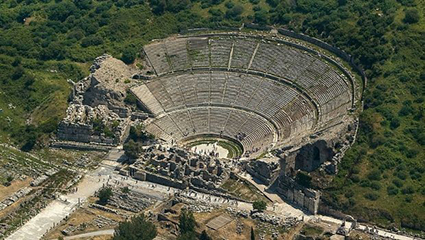
Step through the grand Magnesia Gate, your gateway to the ruins of a once bustling Roman provincial capital. Guided by our knowledgeable guide, commence a gentle, downhill walk through the city's historic heart, passing notable landmarks such as the Odeum, the Celsus Library, the Temple of Hadrian, the Fountain of Trajan and the awe-inspiring Great Theater. Immerse yourself in the rich history, taking in the monumental architecture as you traverse this ancient city.
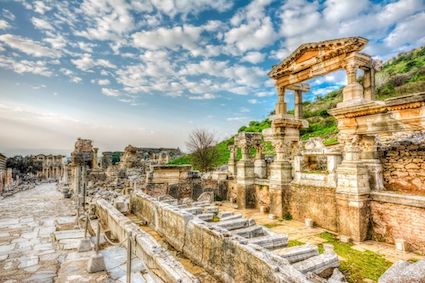
Your journey continues to the stunning Terrace Houses, once the opulent homes of Ephesus's wealthy denizens during the time of Augustus. Admire the beautifully preserved frescoes and mosaics which once adorned the lavish bedrooms, bathrooms, and kitchens.
The tour subsequently escorts you to the revered House of Virgin Mary, nestled in the Solmissos Mountains, which is officially recognized by the Vatican as the final resting place of Mother Mary.
Finally, witness the last remnant of the Seven Wonders of the Ancient World at the Temple of Artemis. Discover the remains of this once majestic Greek temple, an unforgettable highlight to the tour.
After visiting the Temple of Artemis (one of the seven wonders of the ancient world, with one of the most powerful sacred vibrations on earth), this guided tour is punctuated by an authentic Turkish lunch at a local restaurant. The tour culminates at the House of Virgin Mary, concluding with a comfortable transfer back to the cruise ship port.
This tour seamlessly weaves a rich tapestry of history, culture, and spectacular sights, promising an unforgettable exploration of Kusadasi's highlights. Experience the best the town has to offer and create lifetime memories.
Food and Beverage
A full course lunch at a local Turkish restaurant is included in the price.
Recommended Dress
Comfortable clothing and closed-toe, sensible walking shoes are recommended. Sunglasses, sunscreen, and a hat or umbrella are suggested.
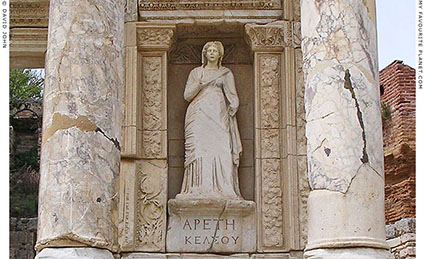
Restrictions
Walking at Ephesus is over actual streets / sidewalks from ancient times which are uneven and worn. There are steps without handrails and packed dirt that must be navigated in some areas. The walk through Ephesus is not wheelchair accessible.
Meeting Instructions
Details will be provided on your ticket.
REGISTER HERE NOW
|
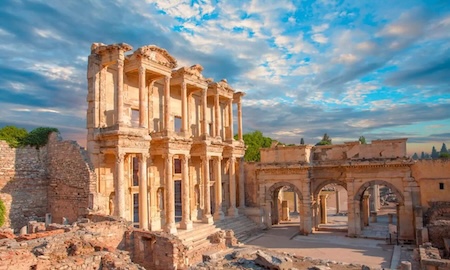
Legends of Ephesus
Artemis is the daughter of Leto and Zeus, and Apollo's twin. She is the goddess of the wilderness, the hunt, wild animals, and fertility. She is the midwives' helper and goddess of birth.
In one legend, Artemis was born one day before her brother Apollo. Right after her birth on the island of Ortygia, she helped her mother Leto to cross the straits to Delos, where Leto then delivered Apollo. Thus began Artemis' role as guardian of young children and patron of women in childbirth.
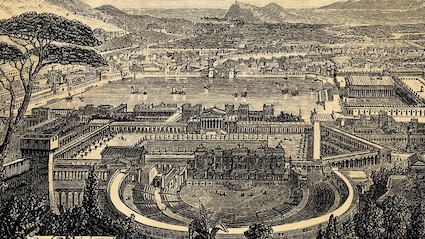
As a goddess of contradictions, Artemis protected women in labor, but her arrows brought them sudden death during childbirth. Like her twin brother Apollo, Artemis was a god of healing, but also brought and spread diseases.
The immortal Artemis and Apollo killed the children of the mortal Niobe, who had boasted to Leto (mother of the divine twins), that because she had more children than Leto, she was superior to her. When Apollo was outraged by this insult, the twin gods hunted and shot them with their bows and arrows. Apollo killed the male children and Artemis the females.
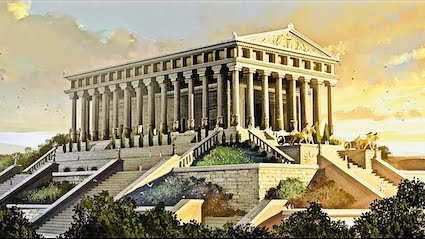
Artemis was worshiped in most Greek cities but only as a secondary deity. However, to Greeks in Asia Minor, she was a prominent deity. In Ephesus, a great temple was built in her honor—one of the "Seven Wonders of the Ancient World." There she was worshipped as a fertility goddess, and was identified with Cybele, the mother goddess of Eastern lands.
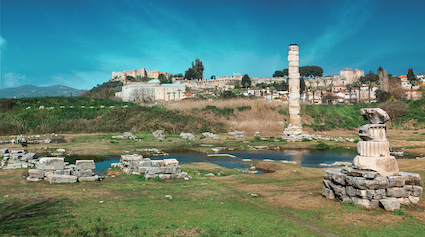
The cult statues of the Ephesian Artemis differ greatly from those of mainland Greece, where she is a huntress with bow and arrows. Those at Ephesus show her in the Eastern style, standing erect with numerous nodes on her chest.
Some say they are breasts, others say they are bulls testes sacrificed to her. Though the true interpretation remains uncertain, we can conclude that they represent fertility.
Artemis at an early age asked her father Zeus to grant her eternal chastity. Also all her companions were virgins. Artemis was very protective of her purity, and gravely punished any man who attempted to dishonor her. Actaeon, while hunting, accidentally came upon Artemis and her nymphs, bathing naked in a secluded pool. The stunned Actaeon stopped and gazed at them, but when Artemis saw him ogling them, she transformed him into a stag. Then she set his own hounds upon him.
They chased and killed what they thought was a stag, but it was really their master.
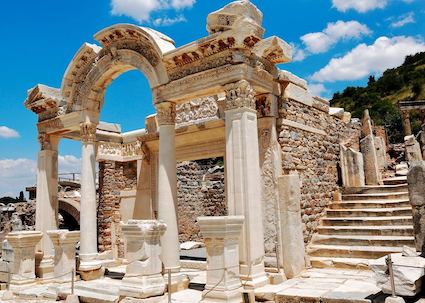
Legend is that Orion, a giant and a great hunter, tried to rape the virgin goddess, so she killed him with her bow and arrows. Another legend says she conjured up a scorpion which killed Orion and his dog. Orion became a constellation in the night sky, and his dog became Sirius, the dog star. Yet another version says the scorpion stung him and was transformed into the constellation Scorpio.
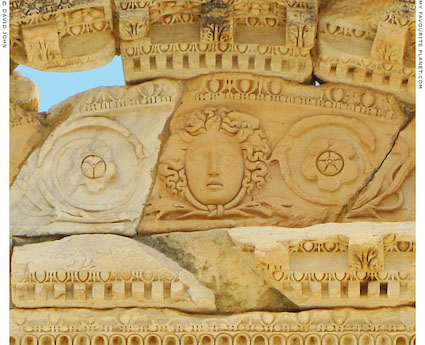
REGISTER HERE NOW
|
|
Delphi, Greece
Special Post-Cruise Excursion
"Oracle of Delphi - Navel of the Earth"
($ Extra Charge)
Sun. Oct. 12, 2025: Debarkation 7:00 am
Tour: 7:30 am to 6:00 pm
(See ticket for meeting time/place)
Activity Level: Active
Special rate expires anytime
Incudes pickup at Cruise Terminal in Piraeus and dropoff at hotel. Luggage allowance on the bus: 1 carry-on and 1 suitcase per person.
REGISTER HERE NOW
Excursion Highlights
• Embark on an unforgettable journey to Delphi, the ancient site of the world's most important oracle.
• Explore the enchanting ruins of Delphi, including the Roman Agora, Sacred Way, and the mystifying Tholos, a masterpiece of the ancient world.
• Immerse yourself in the rich history of the Delphi Archaeological Museum, housing treasures dating from the 18th century B.C. to 300 A.D.
• Enjoy a traditional Greek lunch with wine in the heart of Greece.
Tour Description
After debarking the ship and boarding the bus at the Cruise Terminal in Piraeus, you will begin your journey to Delphi. Along the way, you will see the plain of Beotia, an agricultural center surrounded by cotton plantations and you will also pass through the city of Theva, the birthplace of King Oedipus. You will continue towards Mt. Parnassos, making a brief rest stop outside the town of Levadia.
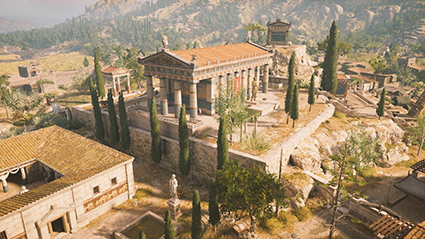
You will then drive on to Delphi, which dates to the ninth century B.C. and whose allure includes an amazing hillside setting and ruins that will intrigue even the most skeptical.
Delphi was the home of the Oracle of Delphi (the Greek world's most important oracle), and the priestess Pythia, famed throughout the ancient world for divining the future and for consulting in all major undertakings.
The area was a religious sanctuary dedicated to the Greek god Apollo after he slew the Python, a deity who protected the navel of the Earth (center of the world) in this location. The sanctuary was home of the Pythian Games, the second most important games in Greece after the Olympics.
You will see the Roman Agora, walk along the Sacred Way, and view the monument of the Argive Kings. the treasury of the Athenians, the Athenian Stoa, the Polygonal Wall, the monument of Platea, and the Temple of Apollo where the oracle resided.
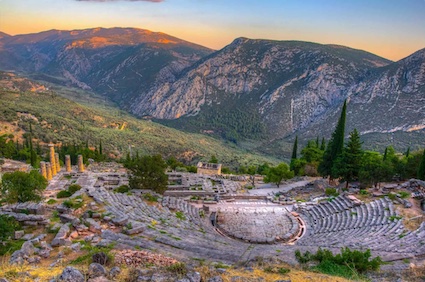
Above the Temple, you may visit the well preserved 3rd-century Theater. On the lower slope of the mountain is the Tholos, a building whose exact purpose is unknown but architecturally speaking is considered one of the masterpieces of the ancient world. You will also see the Palestra where the athletes trained in preparation for the Pythian Games.
After you visit the archeological site, you will visit the adjacent Delphi Archaeological museum which houses the ancient artifacts that were found at the site. As its centerpiece, are the antiquities found in the complex of Oracle which dates from the 18th century B.C. when the oracle was founded to its decline around 300 A.D. Exhibits include the frieze of the Treasury of the Sifnians, the Naxian Sphinx, the metopes of the Athenian treasury, the famous Charioteer, created to commemorate a victory during the 476 B.C. Pythian Games, and many other artifacts.
When visitors approached Delphi, the first structure they saw was the sanctuary of Athena Pronaia — meaning, "Athena who is before the temple (of Apollo)." This sanctuary contained the most characteristic monument at Delphi: the Tholos, a circular building with a conical roof supported by a ring of outer columns.
Visitors would then walk along the Sacred Way, a path to the sanctuary of Apollo that was lined with treasuries and votive monuments.
The central and most important part of Delphi is the temple of Apollo, where the Pythia delivered her prophetic words in the adyton, a separate, restricted room at the rear. The temple of Apollo sat atop a large terrace supported by a polygonal wall.
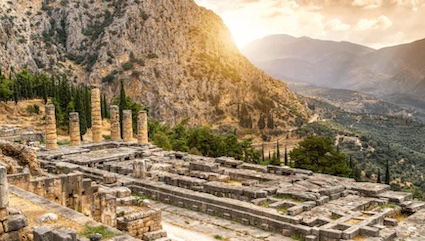
As you tour the site, your guide will bring to life the history and central characters of the site. You will see the Roman Agora, walk along the Sacred Way, and view the monument of the Argive Kings, the treasury of the Athenians, the Athenian Stoa, the Polygonal Wall, the monument of Platea, and the Temple of Apollo where the oracle resided.
Above the Temple, you can visit the well preserved 3rd-century Theater. On the lower slope of the mountain is the Tholos, a building whose purpose is unknown but architecturally speaking is considered one of the masterpieces of the ancient world. You will also see the Palestra where the athletes trained in preparation for the Pythian Games.
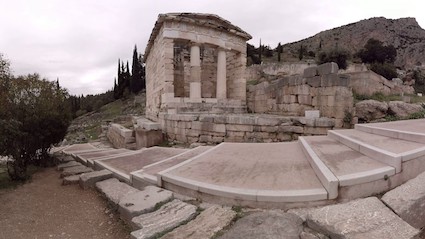
After you tour the site, you will visit the adjacent Delphi Archaeological museum, housing ancient artifacts found at the site. Its centerpiece are antiquities from the Oracle complex, which dates from the 18th century B.C. until its decline around 300 A.D. Exhibits include the frieze of the Treasury of the Sifnians, the Naxian Sphinx, the metopes of the Athenian treasury, and the Charioteer, created to commemorate a victory during the 476 B.C. Pythian Games.
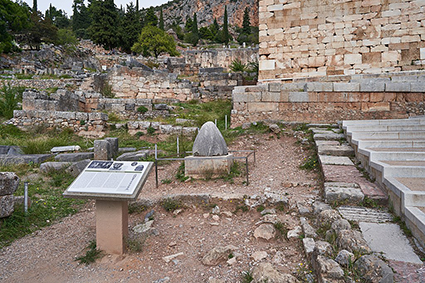
After you visit the museum, rejoin your transportation and begin the drive back to Athens. Along the way, a stop will be made for a traditional Greek lunch with wine. After lunch, you will start your drive back to Athens.
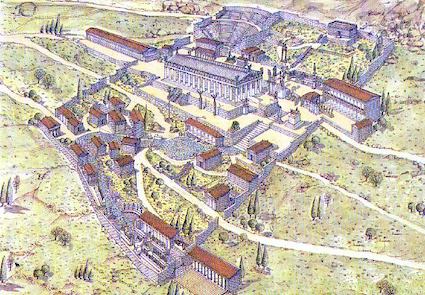
Please Note
The drive to and from Delphi is approximately 3 hours each way. Stops will be made along the way. The site of Delphi is perched on the side of a steep hill and is visited by uphill walking. Those who make the climb are rewarded with a beautiful view over the site and the valley beyond.
Food and Beverage
A traditional Greek lunch with wine is included in the price.
Recommended Dress
Comfortable clothing, sensible, flat-soled walking shoes, sunglasses, sunscreen, and hat or umbrella are suggested.
Restrictions
The hillside site of Delphi requires almost continuous uphill walking over dirt and some paved surfaces to visit. Guests must be in good health and sensible walking shoes are a must. At the museum, there are steps to enter the building.
Meeting Instructions
Details will be provided on your ticket.
REGISTER HERE NOW
|
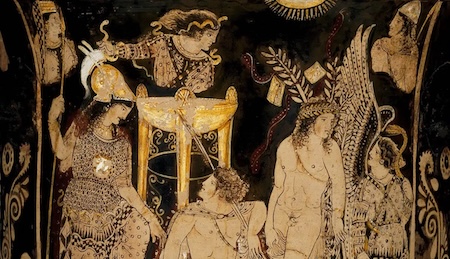
Legend of the Oracle
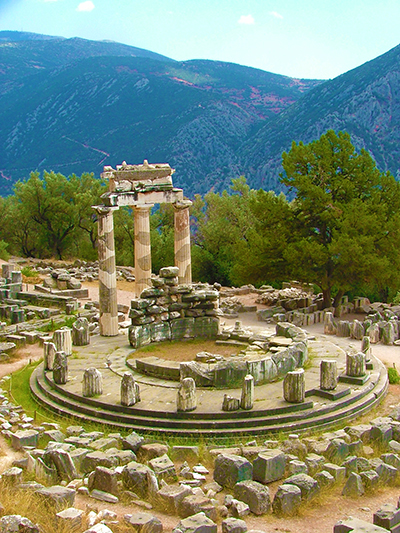
According to Ancient Greek myths, the god Zeus launched two eagles from the two ends of the world, one to the east and the other to the west, in order to find the center of the earth. The eagles, starting simultaneously and flying at equal speed, crossed paths above Delphi. Zeus marked the spot with a sacred stone called the omphalos (meaning "navel"), which was later held at the sanctuary of Apollo. Since then, Delphi has been considered to be the center of the world, the omphalos—"Navel of the Earth."
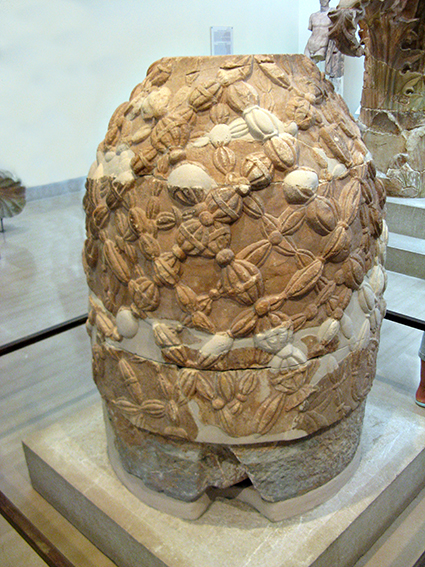
The omphalos is an ancient marble artifact, found at the archaeological site. The original stone is held in the museum of Delphi. A simplified copy sits outdoors at the site where it was found.
In the 2nd century A.D., Pausanias traveled to Delphi and provided rare evidence through his work.
The oval-shaped stone of the omphalos seems to have been decorated in high relief. In ancient times it may have been covered by a mesh of wool cloth, and was kept in the adyton (inner sanctum), beside the tripod and the daphne (bay leaves)—the other sacred symbols of the god. Pausanias described the wool cloth that covered the stone held precious stones designed in the shape of a mermaid, while two gilded eagles were fixed on top of it.
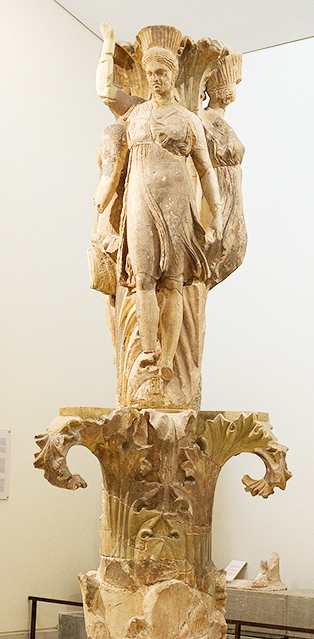
Recent studies by French archaeologists have shown that the omphalos and columns were connected and interlocked. The stone navel was mounted on the bronze tripods supported by the three dancers at the top of the column. This is where the omphalos is thought to have been placed, as a cover of the column, in order to reinforce the meaning and importance of the Athenian votive offering symbolically. The Athenians, wanting to placate and honor the god of light, offered Apollo this copy of the original stone, which combined both Delphic symbols as a gift from the hands of the three priestess figures.
Greeks believed the site was sacred and belonged to Gaia, or Mother Earth, and was guarded by Gaia’s serpent child, Python. Apollo killed Python and founded his oracle there.
According to legend, natives of the island of Crete, accompanied by Apollo in the guise of a dolphin, arrived at the port of Delphi (Kirrha) and built the god’s sanctuary.
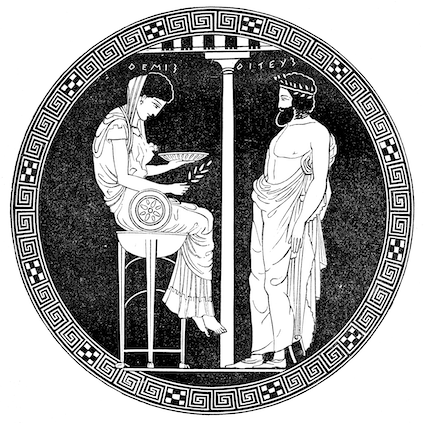
The prestige of the Oracle of Delphi was at its height between the 6th and 4th centuries B.C.
Delphi became a powerful entity, with both rulers and common folk seeking counseling with the Pythia, who only operated a limited number of days over 9 months of the year. These pilgrims brought lavish gifts and offerings. Due to high demand for the oracle's services, affluent people paid great sums to skip to the front of the line. The Oracle was consulted on both private matters and affairs of state. City-state rulers sought advice before launching wars or founding new Greek colonies.
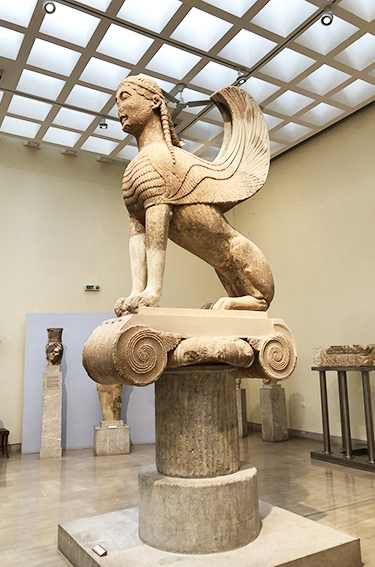
For these consultations, the Pythia would enter the adyton and then sit on a tripod chair, possibly behind a curtain. After Apollo’s priests relayed questions posted by petitioners, the Pythia would inhale light hydrocarbon gasses that escaped from a chasm in the ground, falling into a trance.
The Pythia would then mutter incomprehensible words, which the Apollo priests would translate sometimes conflicting messages for petitioners.
Greeks believed the Oracle of Delphi existed since the dawn of time and accurately predicted historical events such as the Argonaut’s expedition and Trojan War.
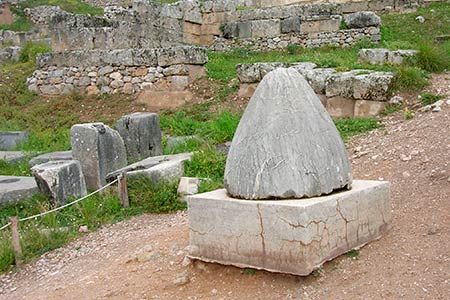
REGISTER HERE NOW
|
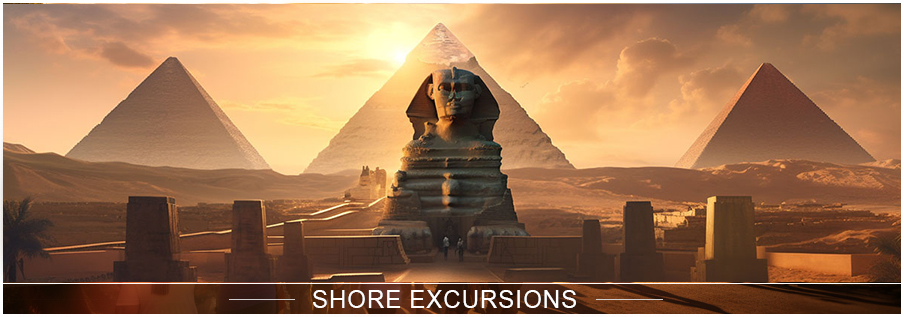

![]()














































